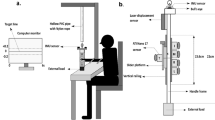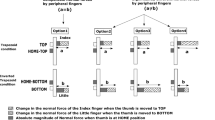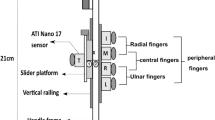Abstract
The moment production by several fingers on a mechanically fixed vertically oriented handle was studied under the systematic variations of task parameters such as (a) moment magnitude (1.0 Nm and 2.0 Nm) and (b) direction of moment production (into pronation and supination), as well as (c) vertical position of the handle from the moment axis, P (0, 2.0, 4.0, and 6.0 cm in both directions). The purpose of this study was twofold: to investigate the dependences between the task parameters and the performance variables and to test the mechanical advantage hypothesis. The performance variables changed symmetrically with P. In particular, magnitudes of the net horizontal and vertical forces both showed an S-shape change. The position of the point of zero free moment (PZFM) was determined. In the intermediate grasp locations (when 0<P magnitude <PZFM), the contribution of M free (moment produced mainly by pronational or supinational effort) and the moment of the resultant force (moment generated mainly by pushing) into the total moment production scaled linearly with the P. The magnitudes of both agonist and antagonist moments (those acting in and against the direction of the required moment, respectively) of normal forces increased with P magnitudes while the magnitude of agonist moments of tangential forces decreased. For individual fingers, the ratio of finger force to its moment arm was not constant. The mechanical advantage hypothesis was successful in explaining some of the data but could not cope with other findings. We assume, therefore, that this hypothesis is limited in its applicability and may be task and effector specific.







Similar content being viewed by others
References
Augurelle AS, Penta M, White O, Thonnard JL (2003) The effects of a change in gravity on the dynamics of prehension. Exp Brain Res 148:533–540
Buchanan TS, Rovai GP, Rymer WZ (1989) Strategies for muscle activation during isometric torque generation at the human elbow. J Neurophysiol 62:1201–1212
Ciriello VM, Webster BS, Dempsey PG (2002) Maximal acceptable torques of highly repetitive screw driving deviation, and handgrip tasks for 7-hour workdays. AIHA J 63:594–604
Dellinges MA, Tebrock OC (1993) A measurement of torque values obtained with hand-held drivers in a simulated clinical setting. J Prosthodont 2:212–214
Flanagan JR, Burstedt MK, Johansson RS (1999) Control of fingertip forces in multidigit manipulation. J Neurophysiol 81:1706–1717
Kerr J, Roth B (1986) Analysis of multifinger hands. Int J Robot Res 4:3–17
Koshland GF, Hasan Z (1994) Selection of muscles for initiation of planar, three-joint arm movements with different final orientations of the hand. Exp Brain Res 98:157–161
Latash ML, Gelfand IM, Li ZM, Zatsiorsky VM (1998) Changes in the force-sharing pattern induced by modifications of visual feedback during force production by a set of fingers. Exp Brain Res 123
Li ZM, Latash ML, Newell KM, Zatsiorsky VM (1998) Motor redundancy during maximal voluntary contraction in four-finger tasks. Exp Brain Res 122:71–78
Li S, Danion F, Zatsiorsky VM, Latash ML (2002) Coupling phenomena during asynchronous submaximal two-hand, multi-finger force production tasks in humans. Neurosci Lett 331:75–78
Li S, Latash ML, Yue GH, Siemionow V, Sahgal V (2003) The effects of stroke and age on finger interaction in multi-finger force production tasks. Clin Neurophysiol 114:1646–1655
Prilutsky BI (2000) Coordination of two- and one-joint muscles: functional consequences and implications for motor control. Motor Control 4:1–44
Schulze LJ, Goldstein D, Patel A, Stanton E, Woods J (1997) Torque production using handwheels of different size during a simulated valve operation task. Int J Occup Saf Ergon 3:109–118
Shih YC, Wang MJ (1997) The influence of gloves during maximum volitional torque exertion of supination. Ergonomics 40:465–475
Shim JK, Latash ML, Zatsiorsky VM (2003) Prehension synergies: trial-to-trial variability and hierarchical organization of stable performance. Exp Brain Res E (pub ahead of print)
Zatsiorsky VM (2002) Kinetics of human motion. Human Kinetics, Champaign, IL
Zatsiorsky VM, Li ZM, Latash ML (1998) Coordinated force production in multi-finger tasks: finger interaction and neural network modeling. Biol Cybern 79:139–150
Zatsiorsky VM, Li ZM, Latash ML (2000) Enslaving effects in multi-finger force production. Exp Brain Res 131:187–195
Zatsiorsky VM, Gregory RW, Latash ML (2002) Force and torque production in static multifinger prehension: biomechanics and control. I. Biomechanics. Biol Cybern 87:50–57
Zatsiorsky VM, Gao F, Latash ML (2003) Prehension synergies: effects of object geometry and prescribed torques. Exp Brain Res 148:77–87
Acknowledgement.
This work was supported in part by grants AR-048563, AG-018751 and NS-35032 from the National Institutes of Health, USA.
Author information
Authors and Affiliations
Corresponding author
Rights and permissions
About this article
Cite this article
Shim, J.K., Latash, M.L. & Zatsiorsky, V.M. Finger coordination during moment production on a mechanically fixed object. Exp Brain Res 157, 457–467 (2004). https://doi.org/10.1007/s00221-004-1859-4
Received:
Accepted:
Published:
Issue Date:
DOI: https://doi.org/10.1007/s00221-004-1859-4




